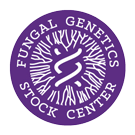Strain: Neurospora crassa
FGSC #2513
Reporting Genes: csp-1 nic-2
Species: crassa
Allele: UCLA37 43002
Depositor: CPS
Linkage Group: IL IR
Mating Type: A
ref1: https://doi.org/10.1093/genetics/78.2.679
Genes

Reporting Genes: csp-1 nic-2
Species: crassa
Allele: UCLA37 43002
Depositor: CPS
Linkage Group: IL IR
Mating Type: A
ref1: https://doi.org/10.1093/genetics/78.2.679
